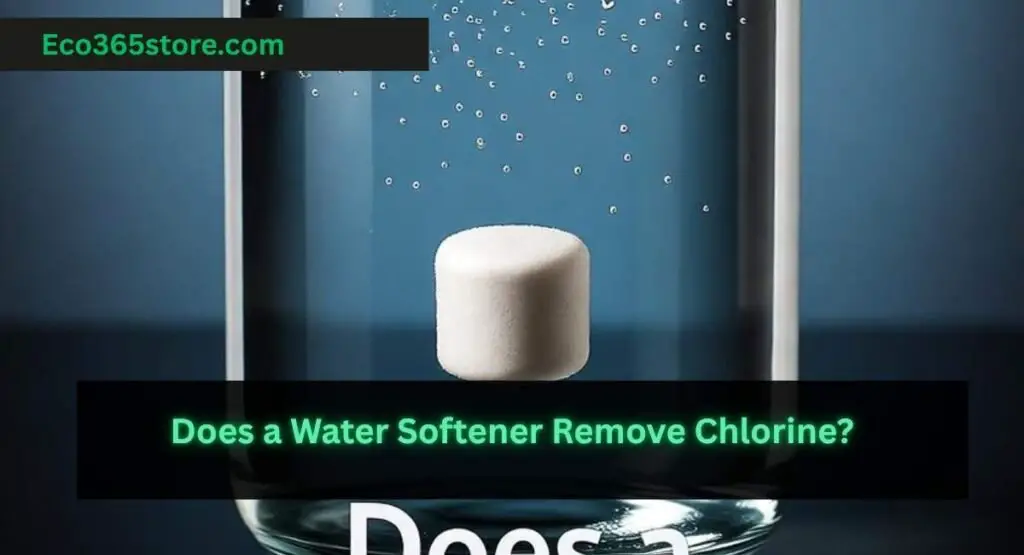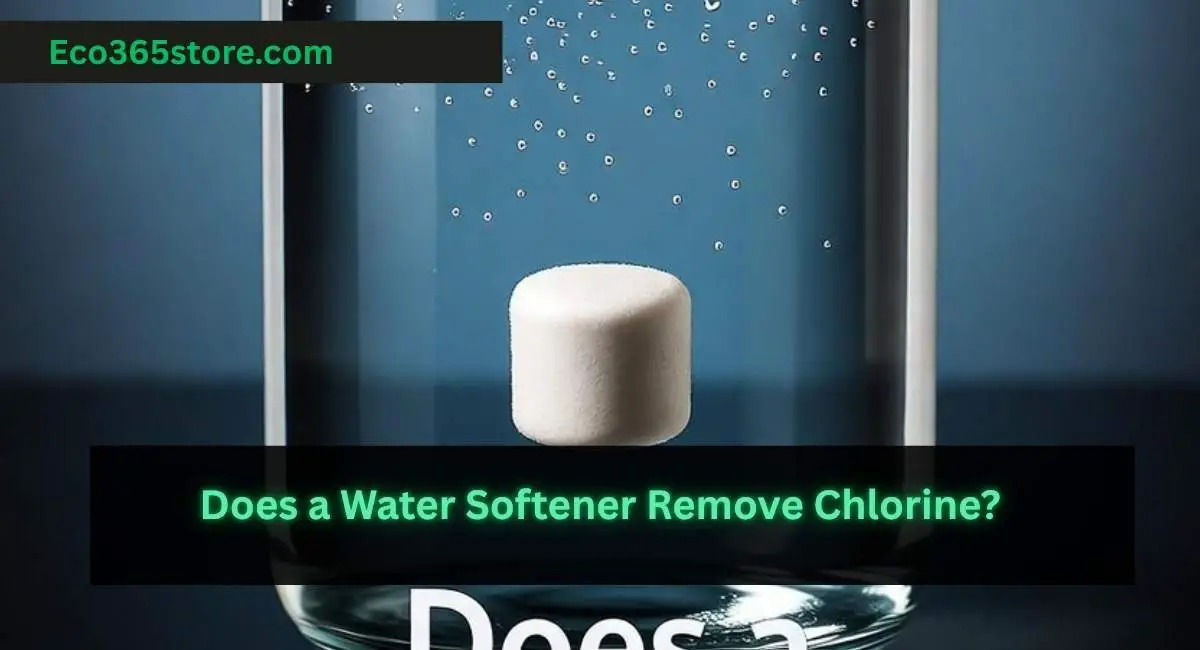If your tap water smells like a swimming pool or has an unpleasant taste, you’re likely dealing with chlorine. This common disinfectant is essential for public water safety, but many homeowners want to remove it for better-tasting water and to protect their appliances. If you have a water softener, you might assume it’s handling the chlorine as well.
This leads to a widespread question: does a water softener remove chlorine?
The short and direct answer is no, a traditional water softener is not designed to remove chlorine. In fact, chlorine can actually damage your softening system. This guide will clear up the confusion, explain what a softener actually does, and show you the most effective ways to eliminate chlorine from your water.
What Does a Water Softener Actually Do?
To understand why a softener doesn’t remove chlorine, it’s crucial to know how it works. A standard water softener is a specialized appliance with one primary job: to remove “hardness” minerals from your water—specifically calcium and magnesium.
This is done through a process called ion exchange. Here’s a simple breakdown:
- Hard Water Enters: Water rich in calcium and magnesium ions flows into the softener’s mineral tank.
- The Swap Happens: This water passes through a resin bed covered in tiny beads charged with sodium (or potassium) ions.
- Minerals are Captured: The resin beads have a stronger attraction to calcium and magnesium than to sodium. They grab the hardness minerals and release the sodium ions in exchange.
- Soft Water Exits: The water leaving the tank is now “soft,” free of the scale-forming minerals.
The key takeaway is that a traditional softener is a mineral exchanger, not a chemical filter. It’s brilliant at solving scale buildup but isn’t designed to filter out disinfectants like chlorine.

Why Is There Chlorine in Water?
Before we look at removal, it’s important to understand why chlorine is in your water in the first place. Municipal water treatment plants add chlorine as a disinfectant. It’s highly effective at killing harmful bacteria, viruses, and other pathogens that can cause waterborne diseases.
This chlorination process is a critical public health achievement. However, to ensure the water remains safe as it travels through miles of pipes to your home, a residual amount of chlorine remains. While this ensures safety, it’s this residual chlorine that causes the familiar chemical taste, odor, and concerns about skin irritation or the potential long-term effects of byproducts.
Can Water Softeners Remove Chlorine?
So, let’s answer the core question directly: Does a water softener remove chlorine?
No, a traditional salt-based water softener does not remove chlorine effectively. The ion exchange resin is designed to target positively charged ions like calcium and magnesium. Chlorine, in its most common form in water (hypochlorous acid), is a neutral molecule that does not participate in the ion exchange process. It simply passes straight through the resin tank.
The Impact of Chlorine on Your Water Softener
Not only does the softener not remove chlorine, but chlorine is actually harmful to your water softener. The resin beads inside the tank are made of a plastic polymer that is slowly degraded and damaged by constant exposure to chlorine. This process, known as “chlorine attack,” can cause the beads to become brittle and break down, reducing the efficiency and lifespan of your entire system.
Note: Some people confuse chlorine with fluoride. It’s important to clarify that the answer to “does a water softener remove fluoride?” is also a definitive no, for the same ion-exchange reasons.
How to Remove Chlorine from Water
If a softener can’t remove chlorine, what can? Fortunately, several highly effective methods exist. For a whole-home solution, these are often installed before the water softener to protect the softening resin.
- Activated Carbon Filtration: This is the gold standard for chlorine removal. Activated carbon filters use a highly porous surface that adsorbs chlorine (and its taste/odor) very effectively. This can be in the form of:
- Whole-House Carbon Filters: Installed at your main water line to treat all the water entering your home.
- Carbon Block/GAC Filters: Used in under-sink systems or as part of a reverse osmosis unit.
- Reverse Osmosis (RO) Systems: A reverse osmosis system is a multi-stage filtration unit that typically includes one or more carbon filters before the RO membrane. These pre-filters are essential for removing chlorine, which would otherwise damage the sensitive RO membrane. RO systems are excellent for providing ultra-pure drinking water at a specific faucet.
- Chemical Neutralization & Evaporation: For small-scale uses, letting water sit in an open pitcher will allow chlorine to evaporate over time. Chemical neutralizers (like campden tablets, used in brewing) are also effective but impractical for whole-house treatment.
The best approach is often to use a water softener in conjunction with a dedicated filtration method. A common and effective setup is a Whole-House Carbon Filter → Water Softener → (Optional) Under-Sink RO for drinking water.
Special Water Softener Models with Chlorine Removal
Recognizing the need for all-in-one solutions, some manufacturers now offer combo systems or specialized media. These are not traditional softeners but rather integrated water conditioning systems.
- Softener-Carbon Combo Units: Some models, like certain Culligan or Aquasana systems, include a built-in activated carbon filter stage, either as a separate tank or as a mixed media within the mineral tank.
- Chlorine-Resistant Resin: Some systems use a more durable resin that can better withstand chlorine, but this still doesn’t mean it removes it.
When selecting a system, look for explicit features like “chlorine removal” or “activated carbon stage,” rather than assuming a standard softener will do the job.
Effects of Chlorine on Plumbing and Appliances
Protecting your softener is just one reason to remove chlorine. Chlorine is a powerful oxidant and can have corrosive effects throughout your home:
- Plumbing: It can accelerate the corrosion of copper pipes and degrade rubber gaskets and seals within your plumbing system and appliances.
- Water Heater: Can contribute to tank corrosion over time.
- Fixtures: May cause pitting and damage to faucet finishes.
By removing chlorine with a whole-house carbon filter, you not only get better-tasting water but also extend the life of your plumbing, water softener, and all water-using appliances.
Conclusion
So, does a water softener remove chlorine? The evidence is clear: a traditional water softener is not the right tool for that job. Its purpose is to combat water hardness, and exposing it to chlorine can actually shorten its life.
For truly comprehensive water treatment, the most effective strategy is a layered approach. Start with a whole-house activated carbon filter to remove chlorine, which will protect your plumbing and your next investment: a water softener to eliminate scale-causing minerals. For the purest drinking water, you can add a reverse osmosis system under your kitchen sink.
To make the right choice, begin by getting a professional water test. This will tell you exactly what’s in your water, allowing you to build the perfect system to address your specific concerns and enjoy clean, soft, and great-tasting water throughout your home.
Ready to solve your water challenges? Contact a local water treatment expert today for a consultation and water test.
Does a water softener remove fluoride?
No. Like chlorine, fluoride is not removed by the ion exchange process of a standard water softener. Reverse osmosis or specialized activated alumina filters are required to remove fluoride.
How do water softeners differ from water filters?
Water softeners are a type of water conditioner that removes hardness minerals via ion exchange. Water filters (like carbon filters) use a physical barrier or adsorption to remove contaminants like chlorine, sediment, and chemicals.
Can reverse osmosis systems replace water softeners?
Not typically. An RO system is designed for point-of-use drinking water and does not provide the volume or flow rate for whole-house softening. They serve different purposes and often work best in tandem.
Why does my softened water still smell like chlorine?
This is the clearest sign that your softener is not removing chlorine. The softening process is working on the minerals, but the chlorine is passing through unchanged, confirming the need for a separate carbon filter.
What maintenance is needed if my water has chlorine?
If you only have a softener, you’ll need to monitor the resin for damage. The best solution is to install a whole-house carbon filter, which will require its own periodic filter changes (typically annually).

Anamika is a passionate writer for Eco365Store.com, specializing in topics that inspire a cleaner, greener world. With expertise in home cleaning, recycling, and eco-friendly solutions, she crafts engaging and informative articles that help readers adopt sustainable practices in their daily lives.

